Near Earth the density of protons in the solar wind (a stream of particles from the Sun) can be 4.63cm−3 and their suced can be 391 km/s. (a) Find the current density of these protons. (b) If Earth's magnetic field did not deflect the protons, what total current would Earth receive?
The correct Answer is:(a) 2.90×10−7A/m2;(b)3.69×107A/m2
To solve the problem step by step, we will break it down into two parts as given in the question.
Part (a): Find the current density of the protons.
1. Identify the formula for current density (J):
The current density J is given by the formula:
J=n⋅e⋅vd
where:
- n = number density of charge carriers (protons in this case)
- e = charge of a proton
- vd = drift velocity of the protons
2. Convert the number density from cm−3 to m−3:
Given that the density of protons n=4.63cm−3:
n=4.63cm−3=4.63×106m−3
3. Use the charge of a proton:
The charge of a proton e is approximately:
e=1.6×10−19C
4. Convert the drift velocity from km/s to m/s:
Given that the drift velocity vd=391km/s:
vd=391×103m/s
5. Substitute the values into the current density formula:
Now we can substitute n, e, and vd into the formula:
J=(4.63×106m−3)⋅(1.6×10−19C)⋅(391×103m/s)
6. Calculate the current density:
Performing the multiplication:
J=4.63×106⋅1.6×10−19⋅391×103
J≈2.90×10−7A/m2
Part (b): Find the total current that Earth would receive.
1. Identify the relationship between current density and total current:
The total current I can be calculated using the formula:
J=IA
Rearranging gives:
I=J⋅A
2. Calculate the cross-sectional area (A):
Assuming the protons are hitting the Earth, the area A can be represented as:
A=πr2
where r is the radius of the Earth. Given r≈6.37×106m:
A=π(6.37×106)2
3. Calculate the area:
A≈3.14×(6.37×106)2≈1.27×1014m2
4. Substitute J and A into the current formula:
I=(2.90×10−7A/m2)⋅(1.27×1014m2)
5. Calculate the total current:
I≈3.69×107A
Final Answers:
- (a) Current density J≈2.90×10−7A/m2
- (b) Total current I≈3.69×107A
The current density J is given by the formula:
J=n⋅e⋅vd
where:
- n = number density of charge carriers (protons in this case)
- e = charge of a proton
- vd = drift velocity of the protons
Given that the density of protons n=4.63cm−3:
n=4.63cm−3=4.63×106m−3
The charge of a proton e is approximately:
e=1.6×10−19C
Given that the drift velocity vd=391km/s:
vd=391×103m/s
Now we can substitute n, e, and vd into the formula:
J=(4.63×106m−3)⋅(1.6×10−19C)⋅(391×103m/s)
Performing the multiplication:
J=4.63×106⋅1.6×10−19⋅391×103
J≈2.90×10−7A/m2
The total current I can be calculated using the formula:
J=IA
Rearranging gives:
I=J⋅A
Assuming the protons are hitting the Earth, the area A can be represented as:
A=πr2
where r is the radius of the Earth. Given r≈6.37×106m:
A=π(6.37×106)2
A≈3.14×(6.37×106)2≈1.27×1014m2
I=(2.90×10−7A/m2)⋅(1.27×1014m2)
I≈3.69×107A
- (a) Current density J≈2.90×10−7A/m2
- (b) Total current I≈3.69×107A
Topper's Solved these Questions
- CURRENT AND RESISTANCEBOOK - RESNICK AND HALLIDAYCHAPTER - CURRENT AND RESISTANCEEXERCISE - Practice Questions (Single Corret Choice Type)
39 Videos
- CURRENT AND RESISTANCEBOOK - RESNICK AND HALLIDAYCHAPTER - CURRENT AND RESISTANCEEXERCISE - Practice Questions (Linked Comprehension)
5 Videos
- CURRENT AND RESISTANCEBOOK - RESNICK AND HALLIDAYCHAPTER - CURRENT AND RESISTANCEEXERCISE - Checkpoints
6 Videos
- CIRCULAR MOTIONBOOK - RESNICK AND HALLIDAYCHAPTER - CIRCULAR MOTIONEXERCISE - CHECK POINTS
6 Videos
- ELASTICITYBOOK - RESNICK AND HALLIDAYCHAPTER - ELASTICITYEXERCISE - PRACTICE QUESTIONS (Integer Type)
3 Videos
Similar Questions
Answer the following questions: (a) The earth's magnetic field varies from point to point in space.
Does is also change with time? If so, on what time scale does it change appreciably?
(b) The earth's core is known to contain iron. Yet geologists do not regard this as a source of earth's magnetism, why?
(c) The charged currents in the outer conducting regions of earth's core are thought to be possible for earth's magnetism. What might be the battery to sustain these currents?
(d) The earth may have even reversed the direction of its field several times during its history of 4 to 5 billion years. How can geologist know about the earth's field in such distant past?
(e) The earth's field departs from its dipole shape substantially at large distances (greater than about 30000km). What agencies may be responsible for this distortion?
(f) Interstellar space has an extremely weak magnetic field of the order of 10−12T. Can such a weak field be of any significant consequence? Explain.
View SolutionA copper wire with density ρ with cross-sectional area S bent to make three sides of a squae frame which can turn about a horizontal axis OO' as shown in figure. The wire is located in uniform vertical magnetic field. Find the magnetic induction if on passing a current I through the wire the frame deflects by an angle θ in its equilibrium position.
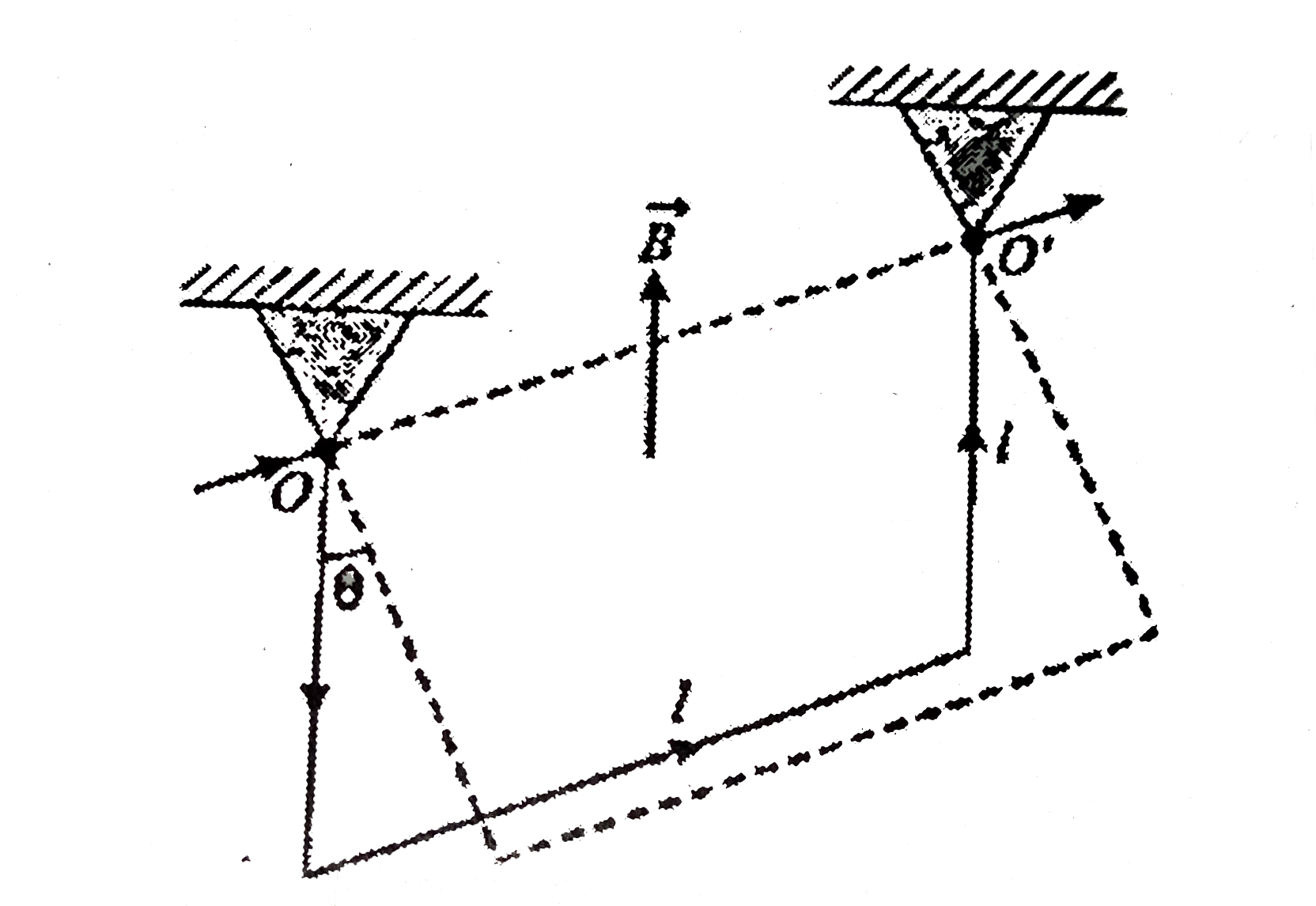
View Solution
Knowledge Check
Read the following text and answer the following questions on the basis of the same:
If we move into space and study the Earth's invisible magnetic field, it wouldn't really look like a bar magnet at all. Earth's magnetic field gets stretched out into a comet-like shape with a tail of magnetism that stretches millions of miles behind the earth, opposite to the Sun. The Sun has a wind of gas that pushes the earths field from the left to the right in the picture.
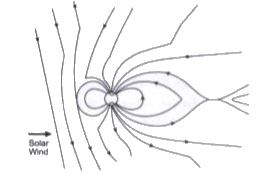
The core of the Earth is an electromagnet. Although the crust is solid, the core of the Earth is surrounded by a mixture of molten iron and nickle. The magnetic field of Earth is caused by currents of electricity that flow in the molten core. These currents are hundreds of miles wide and flow at thousands of miles per hour as the Earth rotates. The powerful magnetic field passes out through the core of the Earth, passes through the crust and enters space. This picture shows the solid inner core region (inner circle) surrounded by a molten outer core (the area between the two circles). The currents flow in the outer core, travel outwards through the rest of the earth's interior. If the Earth rotated faster, it would have a stronger magnetic field.
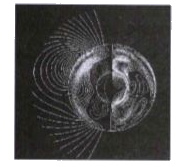
By the time the field has reached the surface of Earth, it has weakened a lot, but it is still strong enough to keep your compass needles pointed towards one of its poles. All magnets have two poles: a North Pole and a South Pole. The magnetic poles of earth are not fixed on the surface, but wander quite a bit. The pole in the Northern Hemisphere seems to be moving northwards in geographic latitude by about 10 kilometres per year by an average.
Earth's magnetic field may increase if:Ait rotates on its axis faster.Bits direction of rotation is changed.Cit revolves round the Sun faster.DAll of the aboveRead the following text and answer the following questions on the basis of the same:
If we move into space and study the Earth's invisible magnetic field, it wouldn't really look like a bar magnet at all. Earth's magnetic field gets stretched out into a comet-like shape with a tail of magnetism that stretches millions of miles behind the earth, opposite to the Sun. The Sun has a wind of gas that pushes the earths field from the left to the right in the picture.
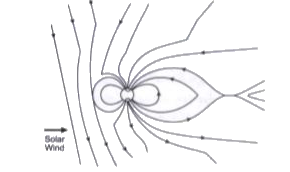
The core of the Earth is an electromagnet. Although the crust is solid, the core of the Earth is surrounded by a mixture of molten iron and nickle. The magnetic field of Earth is caused by currents of electricity that flow in the molten core. These currents are hundreds of miles wide and flow at thousands of miles per hour as the Earth rotates. The powerful magnetic field passes out through the core of the Earth, passes through the crust and enters space. This picture shows the solid inner core region (inner circle) surrounded by a molten outer core (the area between the two circles). The currents flow in the outer core, travel outwards through the rest of the earth's interior. If the Earth rotated faster, it would have a stronger magnetic field.
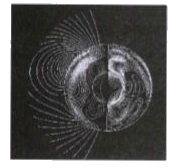
By the time the field has reached the surface of Earth, it has weakened a lot, but it is still strong enough to keep your compass needles pointed towards one of its poles. All magnets have two poles: a North Pole and a South Pole. The magnetic poles of earth are not fixed on the surface, but wander quite a bit. The pole in the Northern Hemisphere seems to be moving northwards in geographic latitude by about 10 kilometres per year by an average.
The Earth's magnetism is due to:Ainduction of Sun's magnetism.Bcurrent produced by the movement of molten metals.Csea current.Drevolution of the Earth round the Sun.Read the following text and answer the following questions on the basis of the same:
If we move into space and study the Earth's invisible magnetic field, it wouldn't really look like a bar magnet at all. Earth's magnetic field gets stretched out into a comet-like shape with a tail of magnetism that stretches millions of miles behind the earth, opposite to the Sun. The Sun has a wind of gas that pushes the earths field from the left to the right in the picture.
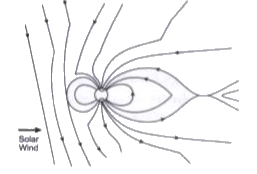
The core of the Earth is an electromagnet. Although the crust is solid, the core of the Earth is surrounded by a mixture of molten iron and nickle. The magnetic field of Earth is caused by currents of electricity that flow in the molten core. These currents are hundreds of miles wide and flow at thousands of miles per hour as the Earth rotates. The powerful magnetic field passes out through the core of the Earth, passes through the crust and enters space. This picture shows the solid inner core region (inner circle) surrounded by a molten outer core (the area between the two circles). The currents flow in the outer core, travel outwards through the rest of the earth's interior. If the Earth rotated faster, it would have a stronger magnetic field.

By the time the field has reached the surface of Earth, it has weakened a lot, but it is still strong enough to keep your compass needles pointed towards one of its poles. All magnets have two poles: a North Pole and a South Pole. The magnetic poles of earth are not fixed on the surface, but wander quite a bit. The pole in the Northern Hemisphere seems to be moving northwards in geographic latitude by about 10 kilometres per year by an average.
The magnetic poles of Earth are:Afixed on the surfaceBwander throughout the Earth's surfaceCwander about 1000 kilometres per year on an average.Dwander about 10 kilometres per year on an average.
The needle of a deflection magnetometer deflects through 45∘ from north to south when the instrument is used in Tan-A position with a magnet of length 10cm placed at a distance of 25cm. (a) Find the magnetic moment of the magnet if the earth's horizontal magnetic field is 20μT. (b) If the magnetometer is used in Tan−B position with the same magnet at the same separation from the needle, what will be the deflection?
View SolutionRead the following text and answer the following questions on the basis of the same:
If we move into space and study the Earth's invisible magnetic field, it wouldn't really look like a bar magnet at all. Earth's magnetic field gets stretched out into a comet-like shape with a tail of magnetism that stretches millions of miles behind the earth, opposite to the Sun. The Sun has a wind of gas that pushes the earths field from the left to the right in the picture.

The core of the Earth is an electromagnet. Although the crust is solid, the core of the Earth is surrounded by a mixture of molten iron and nickle. The magnetic field of Earth is caused by currents of electricity that flow in the molten core. These currents are hundreds of miles wide and flow at thousands of miles per hour as the Earth rotates. The powerful magnetic field passes out through the core of the Earth, passes through the crust and enters space. This picture shows the solid inner core region (inner circle) surrounded by a molten outer core (the area between the two circles). The currents flow in the outer core, travel outwards through the rest of the earth's interior. If the Earth rotated faster, it would have a stronger magnetic field.

By the time the field has reached the surface of Earth, it has weakened a lot, but it is still strong enough to keep your compass needles pointed towards one of its poles. All magnets have two poles: a North Pole and a South Pole. The magnetic poles of earth are not fixed on the surface, but wander quite a bit. The pole in the Northern Hemisphere seems to be moving northwards in geographic latitude by about 10 kilometres per year by an average.
Earth's magnetic field has a:
View SolutionAssume that clouds are distributed around the entire earth at a height of 3000m above the ground. The atmosphere can be modeled as a spherical capacitor with the earth as one plate and the cloud as other. When the electric field between the earth and the cloud becomes large, the air begins to conduct and the phenomena is called lightning. On a typical day 4×105C of positive charge is spread over the surface of the earth and equal amount of negative charge is there on the cloud. Resistivity of the air is ρ=3×1013Ωm and radius of the earth =6000km.
(a) Find the resistance of the air gap between the earth’s surface and cloud.
(b) Estimate the potential difference between the surface of the earth and the cloud
(c) In how much time the capacitor formed between the earth and the cloud will lose 63 % of the charge ?
View SolutionCenters of two similar coils P and Q having same number of turns are located at the coordinates (0.4,0) and (0,0.3) such that the plane of coils are perpendicular to X-and Y-axis respectively. The areas of cross section of coils P and Q are in the ration 4:3 Coil P has 16 A current in clockwise direction and coil Q has 9√3A current in anticlockwise direction as seen from the origin. A small compass needle is placed at the origin. Find the deflection in the needle, assuming the earth's magnetic field negligible and the radii of the coils very small compared to their distances from the origin.
View SolutionA coil of 50 turns and 10cm diameter is made out of a wire of resistivity 2×10−6Ωcm and cross sectional radius 0.1mm. The coil is connected to a source of EMF 10V and of negligible internal resistance.
(a) Find the current through the coil
(b) What must be potential difference across the coil so as to nullify the horizontal component of earth's magnetic field, 0.314×10−4T at the centre of the coil. How should the coil be placed to achieve. this result?
View Solution
